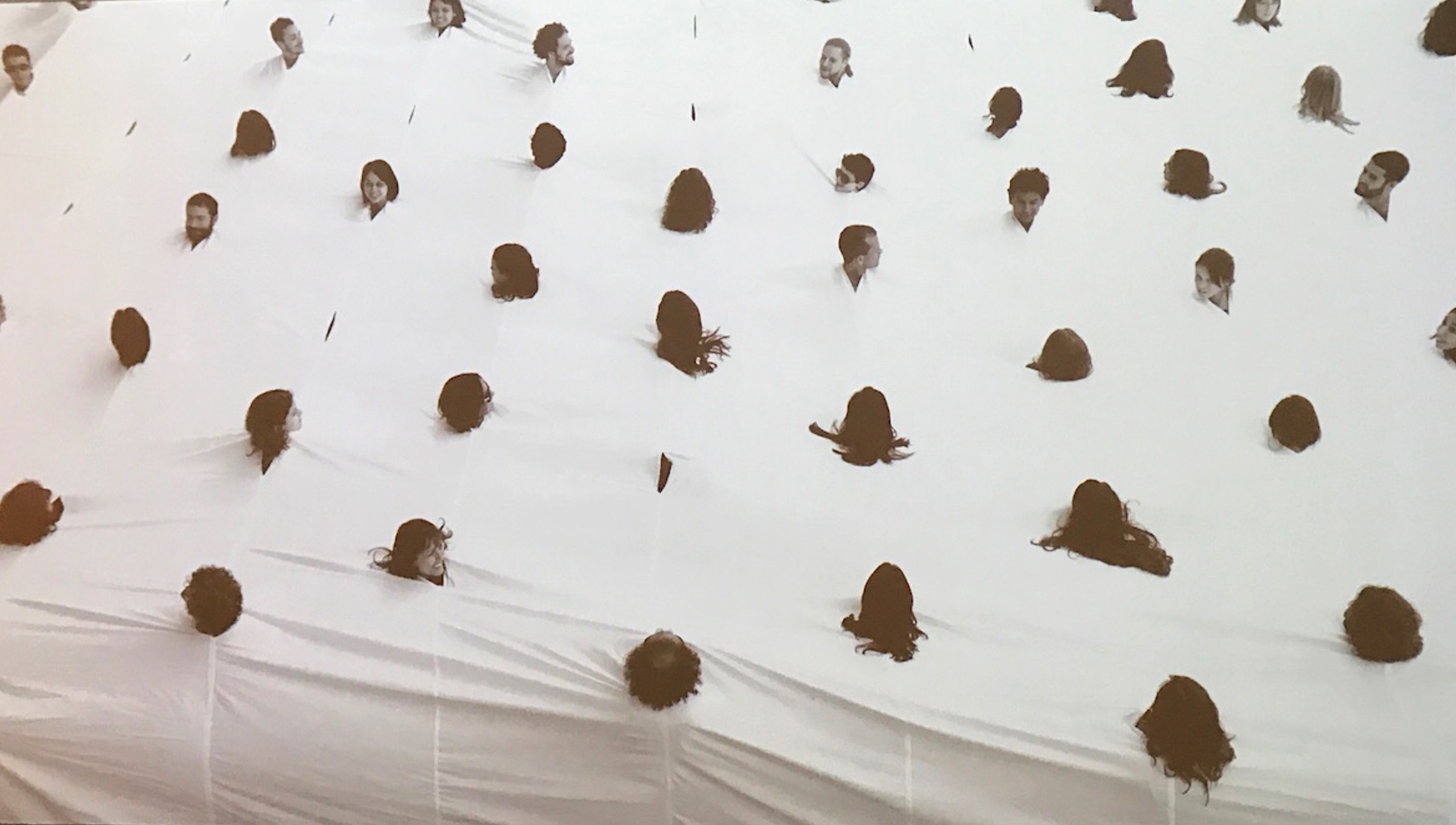
Lygia Pape. Divisor (1968) Performance documentation https://hyperallergic.com/368222/channeling-lygia-papes-radical-relationship-to-space/
Social Action Considered
Through the Language of Textiles
by Paulina Berczynski
In considering the potential of communication, self-determination and participation in crafting new social realities, textiles provide both metaphor and meaning.
Interstice
: a gap or break in something generally continuous
: the interstices
of society
: the spaces between the fibers in woven cloth
Horizontal
: parallel to, in the plane of, or operating in a plane parallel to the horizon or to a baseline
: relating to, directed toward, or consisting of individuals or entities of similar status or on the same level
Textiles are constructed around a shifting nothingness - around the barely-noticed interstitial gaps between their fibers. It may seem insignificant, or some technicality in the weave, but the interstice is what gives fabric its potential for movement. As we handle a piece of cloth, moving the weight of it from one hand to the other, the drape and flow is determined by these spaces, the fibers, and the construction method employed. The fabric may fall through our fingers and pool in the center, as the entire construction shifts inward and towards the ground. Textiles are forever gravitationally slipping, seemingly always trying to reconnect with the horizontal plane.
Textile works often move from the horizontal plane of their creation to the vertical plane of display when their value is recognized not as a functional or utility object, but when communicating a direct message, or as art. In the vertical plane, objects speak. Think of a protest banner made of a bedsheet. This is an object from the horizontal plane repurposed, and repositioned to make a statement. It has moved to a vertical orientation, the one for telling and showing.
Textile works often move from the horizontal plane of their creation to the vertical plane of display when their value is recognized not as a functional or utility object, but when communicating a direct message, or as art. In the vertical plane, objects speak. Think of a protest banner made of a bedsheet. This is an object from the horizontal plane repurposed, and repositioned to make a statement. It has moved to a vertical orientation, the one for telling and showing.
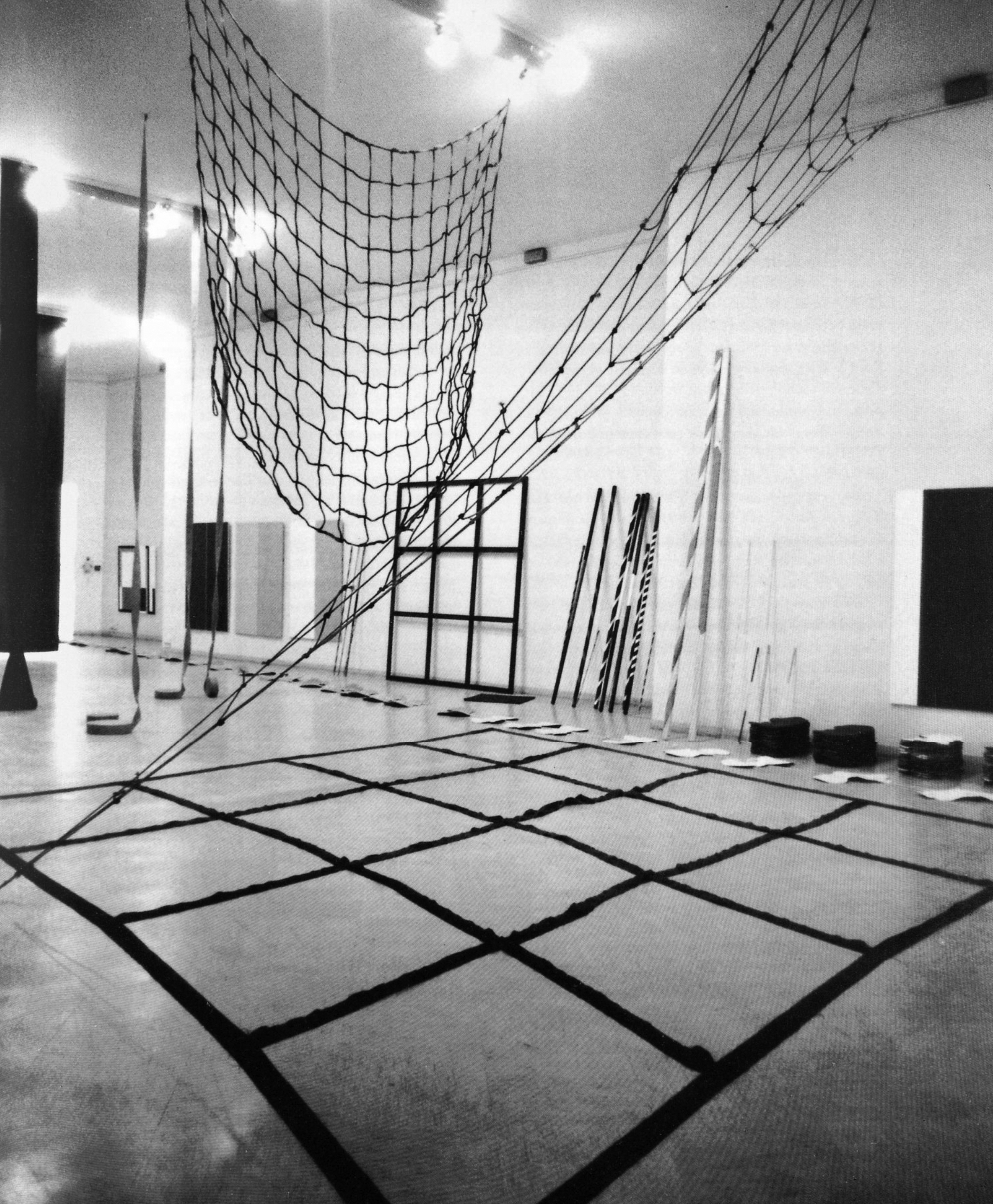 “Support-Surface,” exhibition, ARC (Animation – Recherche – Confrontation), Musée d’Art Moderne de la Ville de Paris, September 23-October 15, 1970. Installation photo. Source: Selva Journal. Selvajournal.org
“Support-Surface,” exhibition, ARC (Animation – Recherche – Confrontation), Musée d’Art Moderne de la Ville de Paris, September 23-October 15, 1970. Installation photo. Source: Selva Journal. Selvajournal.orgSociety
: a community, nation, or broad grouping of people having common traditions, institutions, and collective activities and interests
Born of the Paris Riots in 1968, the French leftist artistic movement Supports/Surfaces laid bare the supports and surfaces in painting as a way to address the cultural moment, question the structures in society and address the class struggle.
The movement was made up of Parisian artists who foregrounded revolutionary theory, and provincial artists who foregrounded labor and craft. The group came together seeking to demystify art practice, and shift emphasis away from the individual creator towards ideals of collective work and group identity.
The artists in Supports/Surfaces believed that painting should be stripped of signifiers and the potential for interpretive depth so that it would reference only itself. They interrogated art and its place in culture, calling it out as an often pseudo-revolutionary practice situated within a bourgeois framework and society. The movement was led by Marxist ideology that centered the deconstruction of social foundations amid the class struggle. As such, the participating artists thought the artistic labor of painting should be based on philosophical and political theory, which itself should be based on social practice - social labor done not in the studio but out in the world.

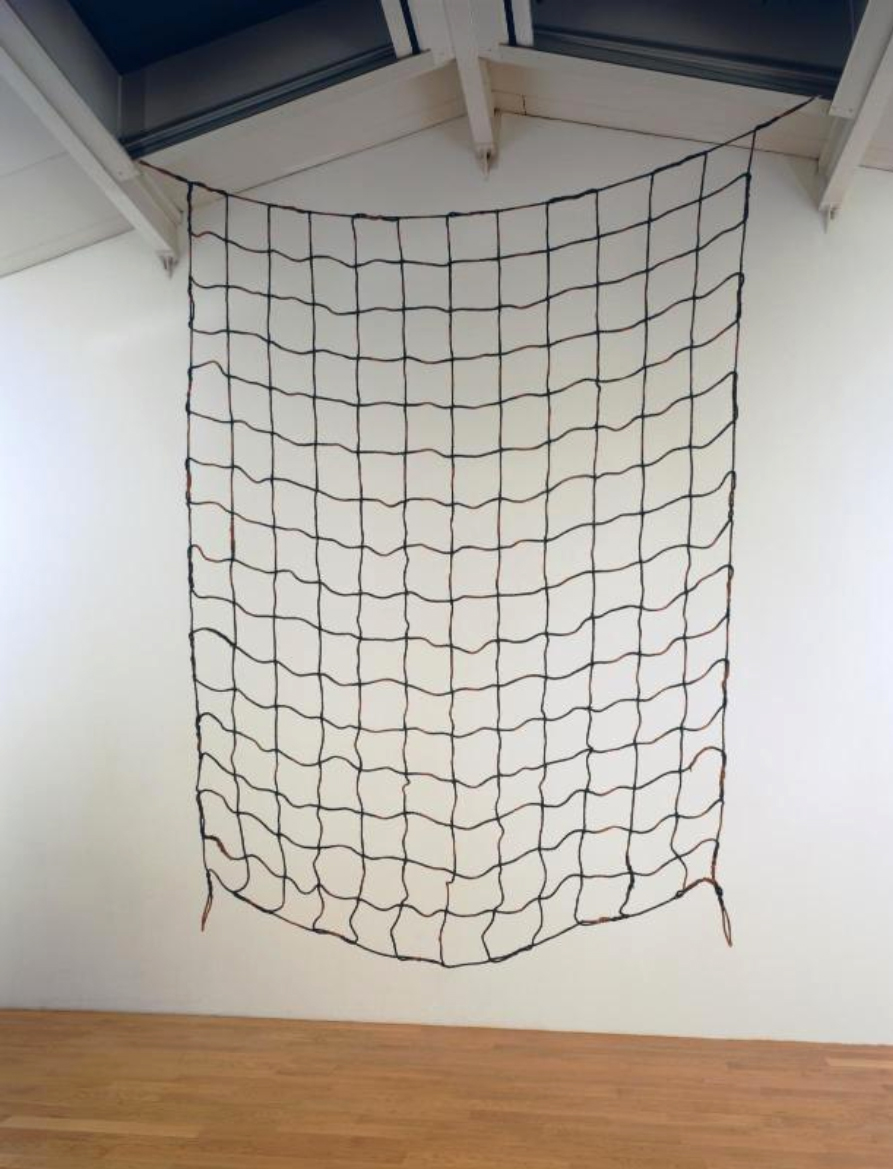
Claude Viallat.Filet. 1970. 342 x 417 cm. Image: Centre Pompidou. https://www.centrepompidou.fr/en/ressources/oeuvre/cAbKk8Right: Daniel Dezeuze, outdoor installation, Cité des Arts, Paris, 1972. Selva Journal Selvajournal.org
Supports/Surfaces’ exhibitions highlight themes of repetition, a lack of figuration, and most vitally a questioning of the relationship between what is the support structure and what is the surface in the work. In deconstructing painting, often into objects, the invisible gaps in the revealed structures are shown as potential sites for creation, participation, individual freedom and self-actualization within and despite the hegemonic framework of a capitalist system of repression. Supports/Surface artists, Claude Viallat, in his net-like hanging sculptures, and Daniel Dezeuze, in his experiments with grid-like open matrices, both rely on the interstice in their work. By presenting empty, unsteady structures that seem to highlight what is not there, both artists present the interstice as a challenge to society and to order.
Colloquial
: used in or characteristic of familiar and informal conversation
: using a conversational style
Society is a framework based on shared values, or some shared understanding.
Likewise, the art world’s value system views art as a commodity, lionizing the artist’s perspective and vision, and often insisting on the primacy of the white wall as a neutral plane of display. The wall mediates a textile object’s intrinsic colloquial language by situating it in a more formal context.

Domestic Integrity Fields. 2014 Installation documentation from The Possible, Berkeley Art Museum. Image: https://www.the-possible.org/texts/ThePossible_Index.pdf. page 21
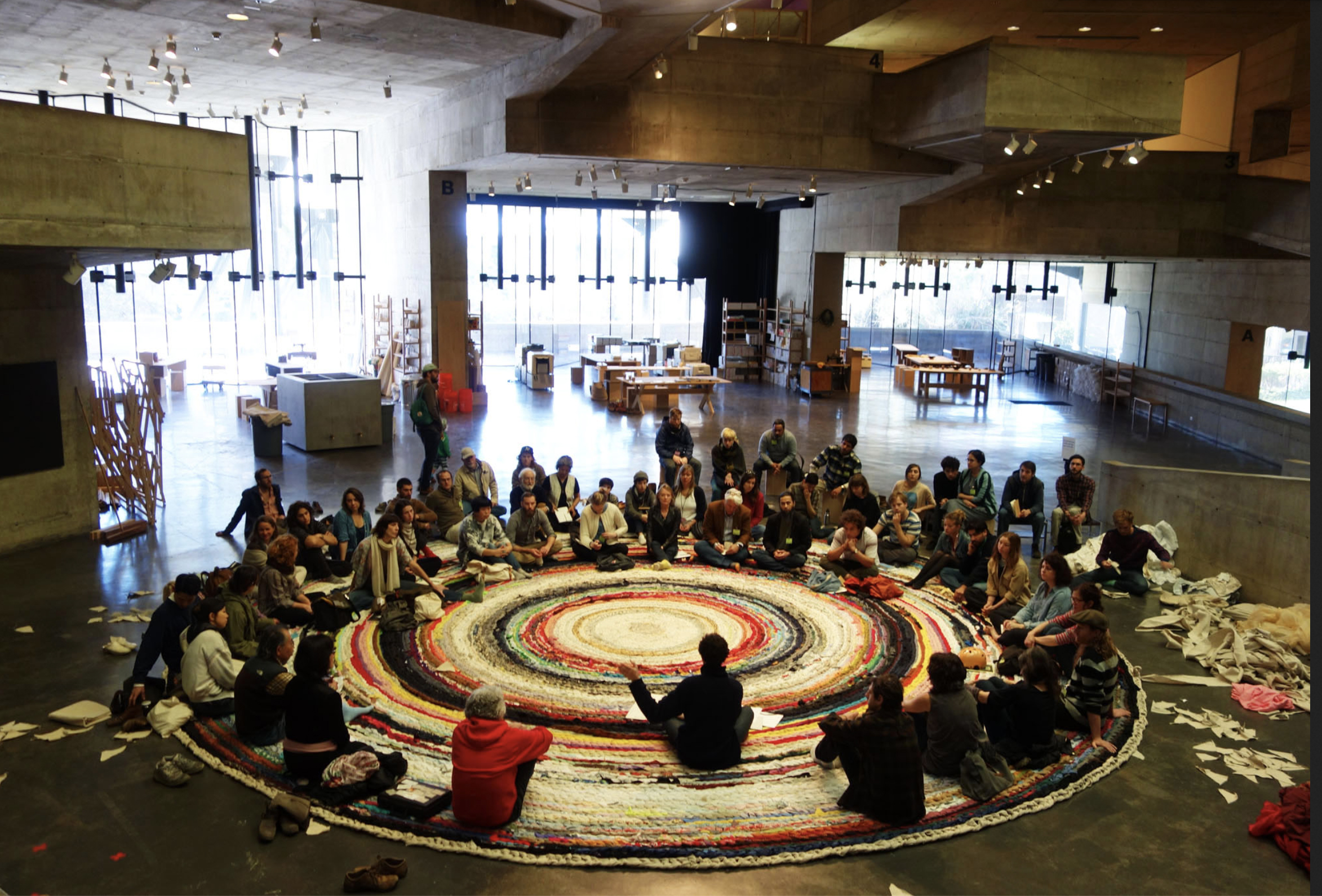
Domestic Integrity Fields. 2014 Installation documentation from The Possible, Berkeley Art Museum. Image courtesy of the Artist’s website
Most artists don’t display textile works on the floor but when they do, it’s part of a loaded and intentional statement.
Fritz Haeg’s Domestic Integrity Fields established 2012 “are crocheted rugs of local textiles upon which the project is presented, functioning as charged sites for testing, performing, and presenting how we want to live.”1 In various iterations, small platforms are placed on the rug as little altars to local participants’ daily domestic labors and experiments integrating the natural world, such as canned food or fresh picked flowers.
In the work’s A06 Iteration at Berkeley Art Museum’s exhibition The Possible (2014), the rug was activated in the museum’s central rotunda, and was the site of multiple participatory workshops where museum visitors could work on the rug using donated and found textiles under the direction of volunteers trained in crochet. In this installation, Haeg’s Domestic Integrity Fields recreated a familiar domestic space inside of a formal art museum context. By displaying the rug horizontally on the ground, Haeg reinforced its familiarity as a site for community building, and recalled the open vibe of circle-time.
The form invited a horizontal, equal plane of relation. As part of this experimental exhibition that mined the museum’s potential as a site for creative convergence, the rug also served as a meeting space for The Possible’s participating artists, and for group movement activities centering hand-crafted wearable sculptures.
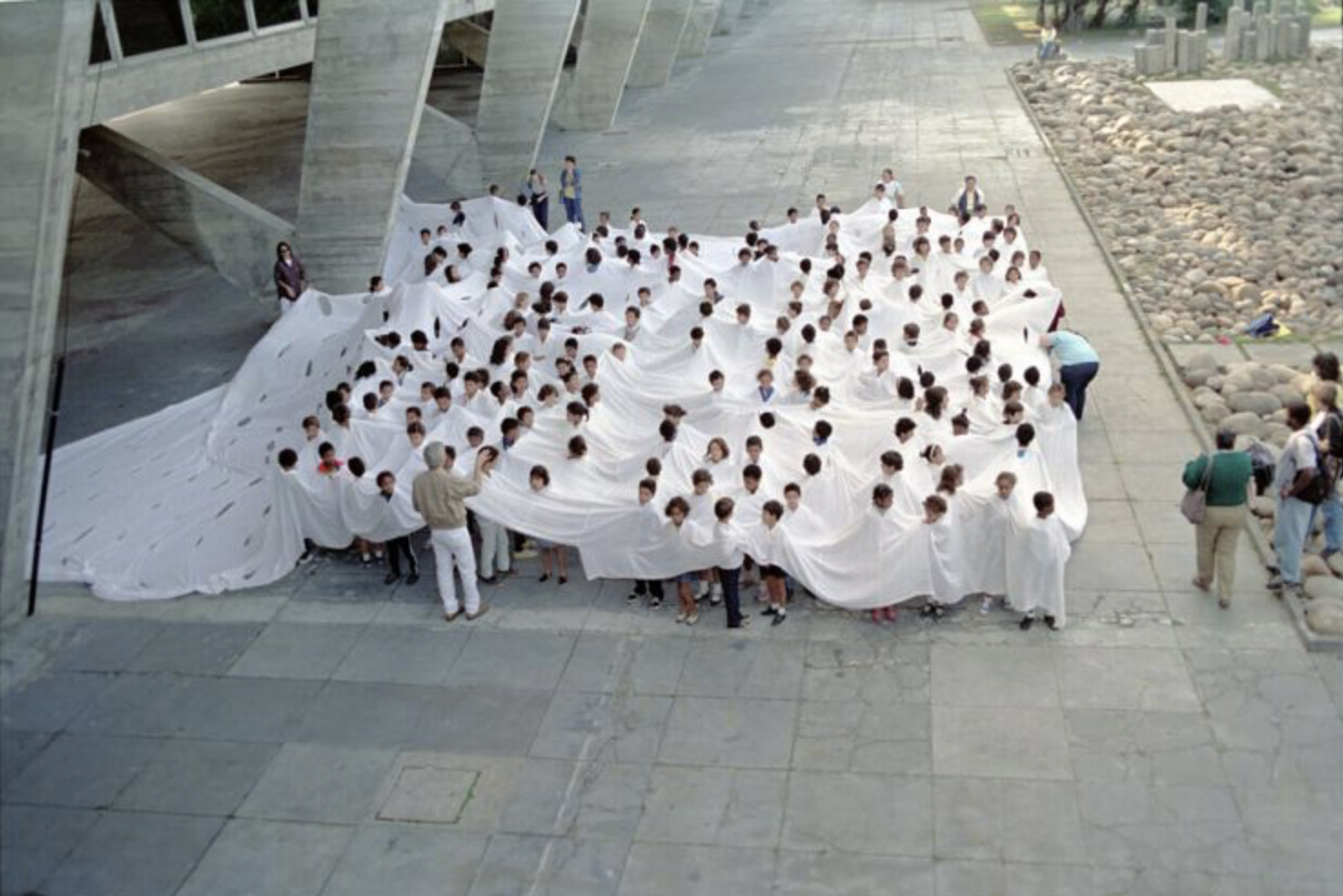
Divisor, 2010, Courtesy Projeto Lygia Pape and Hauser & Wirth, Museum für Moderne Kunst Frankfurt am Main Archive. http://www.dreamideamachine.com/en/?p=31598
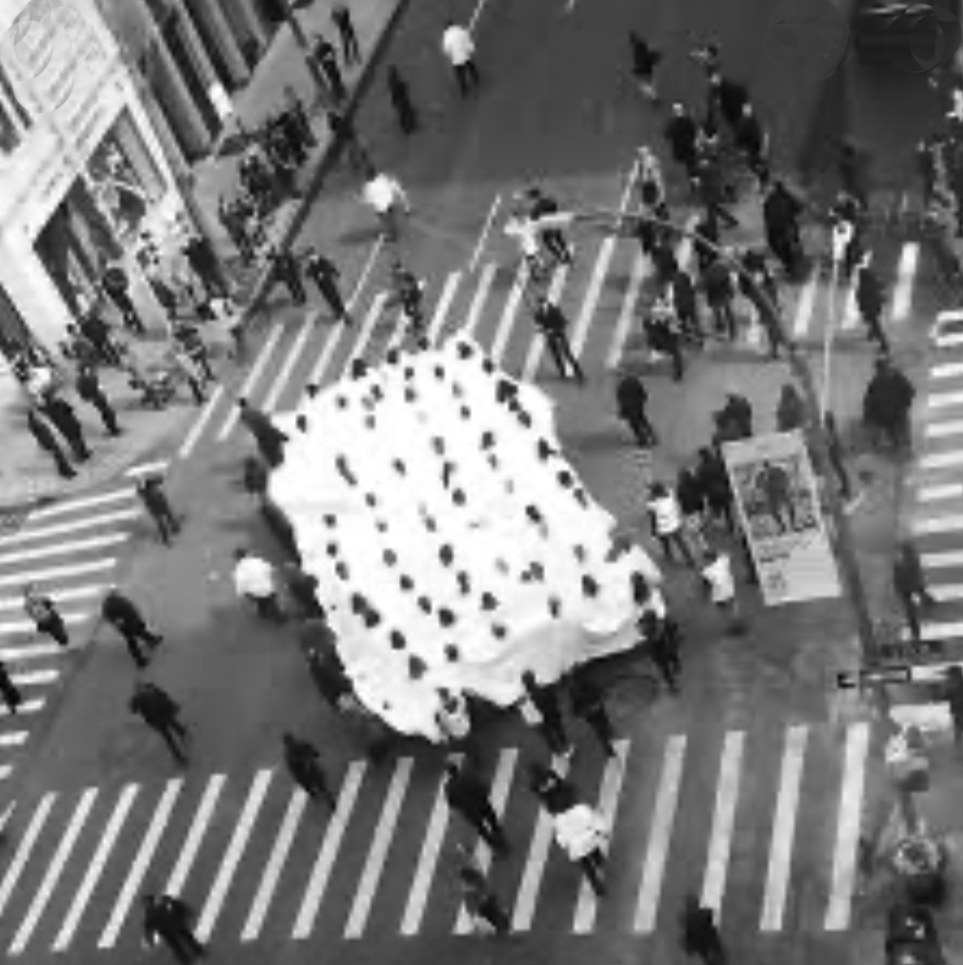
Divisor: performance documentation. Image Courtesy of The Met Breuer. Facebook, Mar 25, 2017
Lygia Pape’s participatory textile work Divisor, first presented in 1968, centered audience participation and collective movement during Brazil’s repressive military dictatorship.
The piece takes the form of a giant white sheet with holes cut out for participants to stick their heads through, inviting the participant or viewer into the space of the piece. In using this form, Pape insists on the presence of people to activate her work- this piece could not exist without participants to fill the holes and create movement. Likewise, protest movements can not exist without people willing to “stick their necks out” against an environment of systemic repression, apathy, and fear.
The work’s first activation involved children from favelas (Brazil’s slums) moving through public space, and has since been re-enacted in Rio’s Museum of Modern Art and the Met Breuer. The work stemmed from Pape’s visionary interest in breaking through the division between the space of the artwork and the space of the viewer. In activating a populace moving through public space, Pape’s Divisor invites the participant and viewer into an expanded field of sculpture that transcends the material, centering collectivity and action in a metaphor for political resistance.
The piece takes the form of a giant white sheet with holes cut out for participants to stick their heads through, inviting the participant or viewer into the space of the piece. In using this form, Pape insists on the presence of people to activate her work- this piece could not exist without participants to fill the holes and create movement. Likewise, protest movements can not exist without people willing to “stick their necks out” against an environment of systemic repression, apathy, and fear.
The work’s first activation involved children from favelas (Brazil’s slums) moving through public space, and has since been re-enacted in Rio’s Museum of Modern Art and the Met Breuer. The work stemmed from Pape’s visionary interest in breaking through the division between the space of the artwork and the space of the viewer. In activating a populace moving through public space, Pape’s Divisor invites the participant and viewer into an expanded field of sculpture that transcends the material, centering collectivity and action in a metaphor for political resistance.
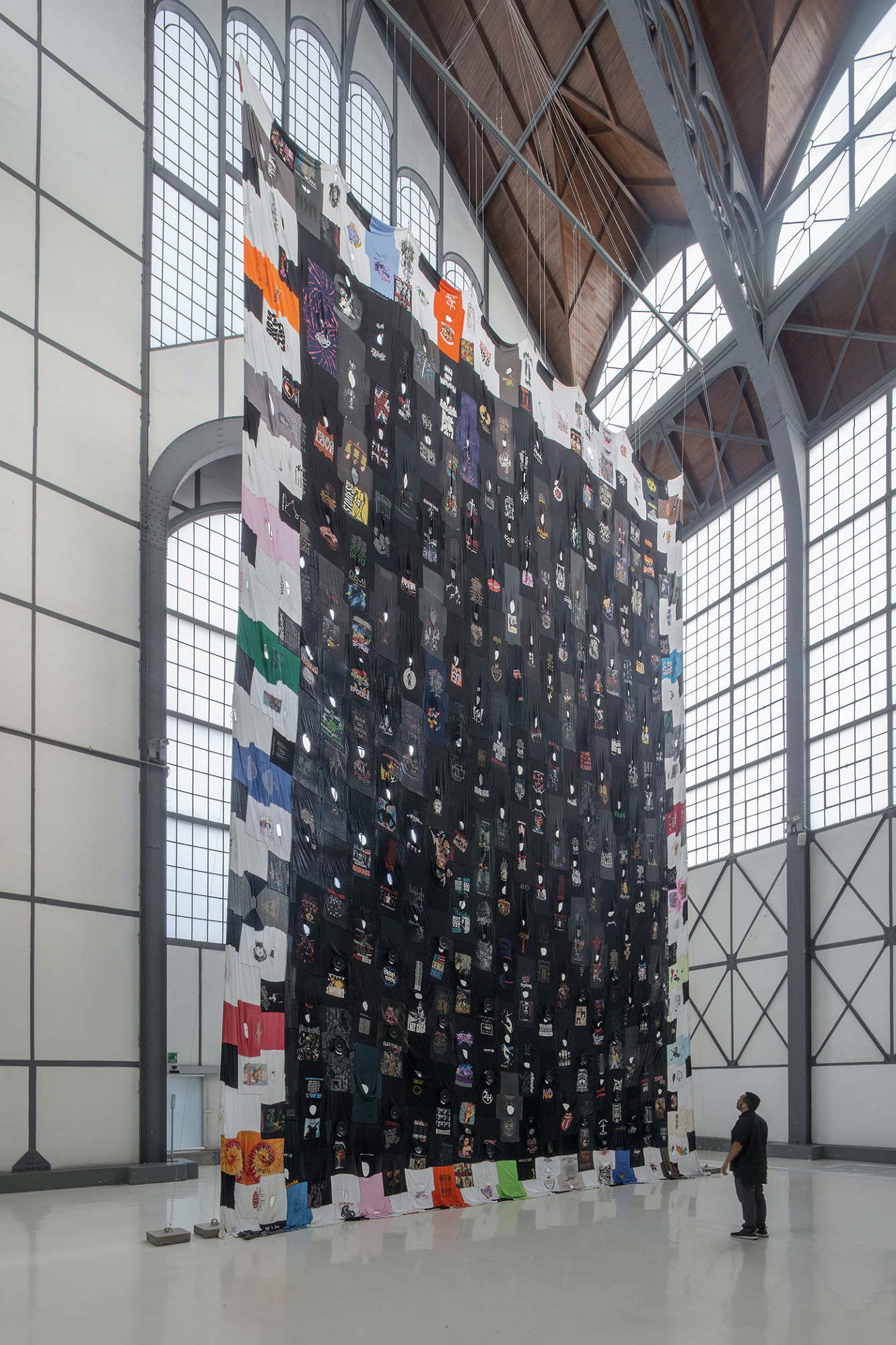
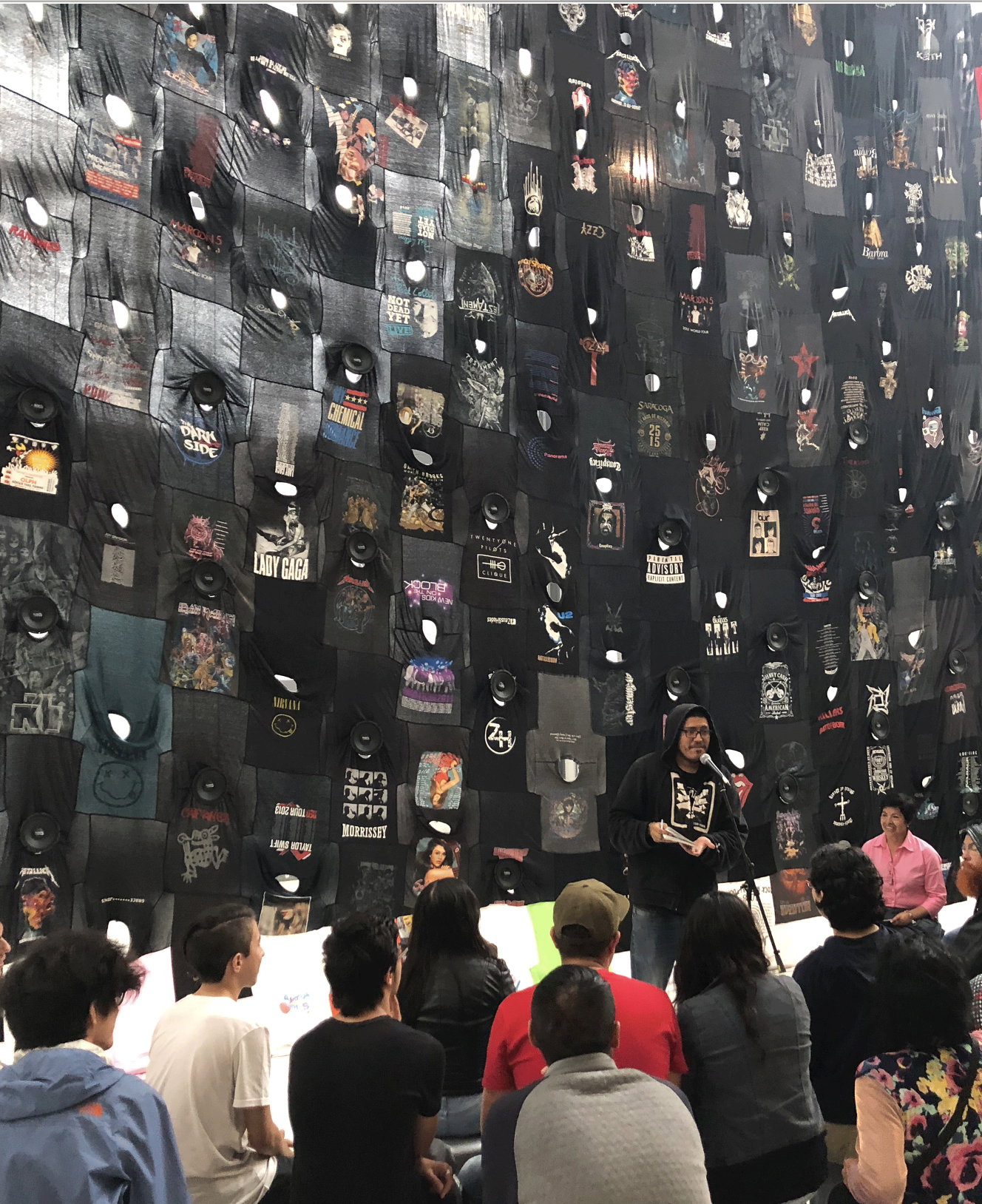 Telón de Boca. Pia Camil in collaboration with seamstresses Virginia Juárez, Gabriela Salas and Citlali Salas.
Telón de Boca. Pia Camil in collaboration with seamstresses Virginia Juárez, Gabriela Salas and Citlali Salas.Left: Installation view at Museo Universitario del Chopo, Mexico City. Photo: Ramiro Chaves
Right: Documentation during Open Mic at Museo Universitario del Chopo. Image courtesy of the Artist at www.PiaCamil.me
Often, textiles communicate using the colloquialisms of the familiar. Rugs, soft sculpture, quilts and wearables all reference their domestic origins. Their communicative power originates in their relatability. They point to common understandings and experiences through the soft, material nature of the medium.
Contemporary Mexican artist Pia Camil plays off of Pape’s Divisor in a series of participatory works that substitute Pape’s massive perforated white sheet with giant textiles sewn of second-hand teeshirts. Several works in this series derive directly from Divisor, maintaining the horizontality of the original, and the openings (or interstices) for individuals to poke their heads through and activate the work. For Telón De Boca, Camil employs the same sewn-teeshirt form, but switches the orientation of the work to act as a backdrop to performance. In this work, the shirt neck holes are not spaces to be activated through group participation and street performance as in the others or as in Divisor. Instead, the piece hangs as a huge monument to rebellion and community outside of popular culture.
Telón de Boca is based around “Tianguis Cultural del Chopo”, a punk and metal identified street market in Mexico City, the music of which is integrated into the textile through 24 speakers. The work speaks to consumerism, alternative economic systems, and the desire to identify and belong across cultures and subcultures. It consists of band shirts sourced at the market. These shirts were produced in Latin America, sold in the US, discarded and re-sold as bales in Mexico, then traded further by the artist before being sewn into a taut vertical curtain. The neckholes in this piece immediately evoke the originally intended wearers–those that would be identified with these musical subcultures. It’s taut presentation and the contrast of the negative space of the neck holes against the black teeshirts that make up the body of this work bring a visible tension to this piece; Telón De Boca recalls an empty mosh pit, charged with tension, inviting a scene.
Contemporary Mexican artist Pia Camil plays off of Pape’s Divisor in a series of participatory works that substitute Pape’s massive perforated white sheet with giant textiles sewn of second-hand teeshirts. Several works in this series derive directly from Divisor, maintaining the horizontality of the original, and the openings (or interstices) for individuals to poke their heads through and activate the work. For Telón De Boca, Camil employs the same sewn-teeshirt form, but switches the orientation of the work to act as a backdrop to performance. In this work, the shirt neck holes are not spaces to be activated through group participation and street performance as in the others or as in Divisor. Instead, the piece hangs as a huge monument to rebellion and community outside of popular culture.
Telón de Boca is based around “Tianguis Cultural del Chopo”, a punk and metal identified street market in Mexico City, the music of which is integrated into the textile through 24 speakers. The work speaks to consumerism, alternative economic systems, and the desire to identify and belong across cultures and subcultures. It consists of band shirts sourced at the market. These shirts were produced in Latin America, sold in the US, discarded and re-sold as bales in Mexico, then traded further by the artist before being sewn into a taut vertical curtain. The neckholes in this piece immediately evoke the originally intended wearers–those that would be identified with these musical subcultures. It’s taut presentation and the contrast of the negative space of the neck holes against the black teeshirts that make up the body of this work bring a visible tension to this piece; Telón De Boca recalls an empty mosh pit, charged with tension, inviting a scene.
The interstices in fabric determine how the textile object hangs and how it reacts to its repositioning from the horizontal plane.
The word interstice comes from the Latin, to stand between. The interstice presents a challenge to order. It allows for articulation within the confines of an otherwise fixed structure. It is a site of experimentation and the unknown. The interstice presents a questioning space and a challenge to political and social norms.
The interstices in textiles, as in society, hold the possibility of movement and change. Artists construct all manner of frameworks and invisible supports to provide structure, or just let the thing hang, because imposing structure is sometimes impossible. Fabric as an object reflects the human condition; it can only be fixed through the denial of its nature. Displaying the work is a negotiation–the will of the artist to pin down what is always moving. In The Direction of Cloth: the Horizontal Dimension Lois Martin writes “There is something about cloth that hates a wall…Perhaps it is time to consider cloth’s limp unruliness as a sort of nonviolent resistance.”2 Here, Martin imbues textile media with a life of its own, a stance against control by the artist and resistance of the vertical plane.
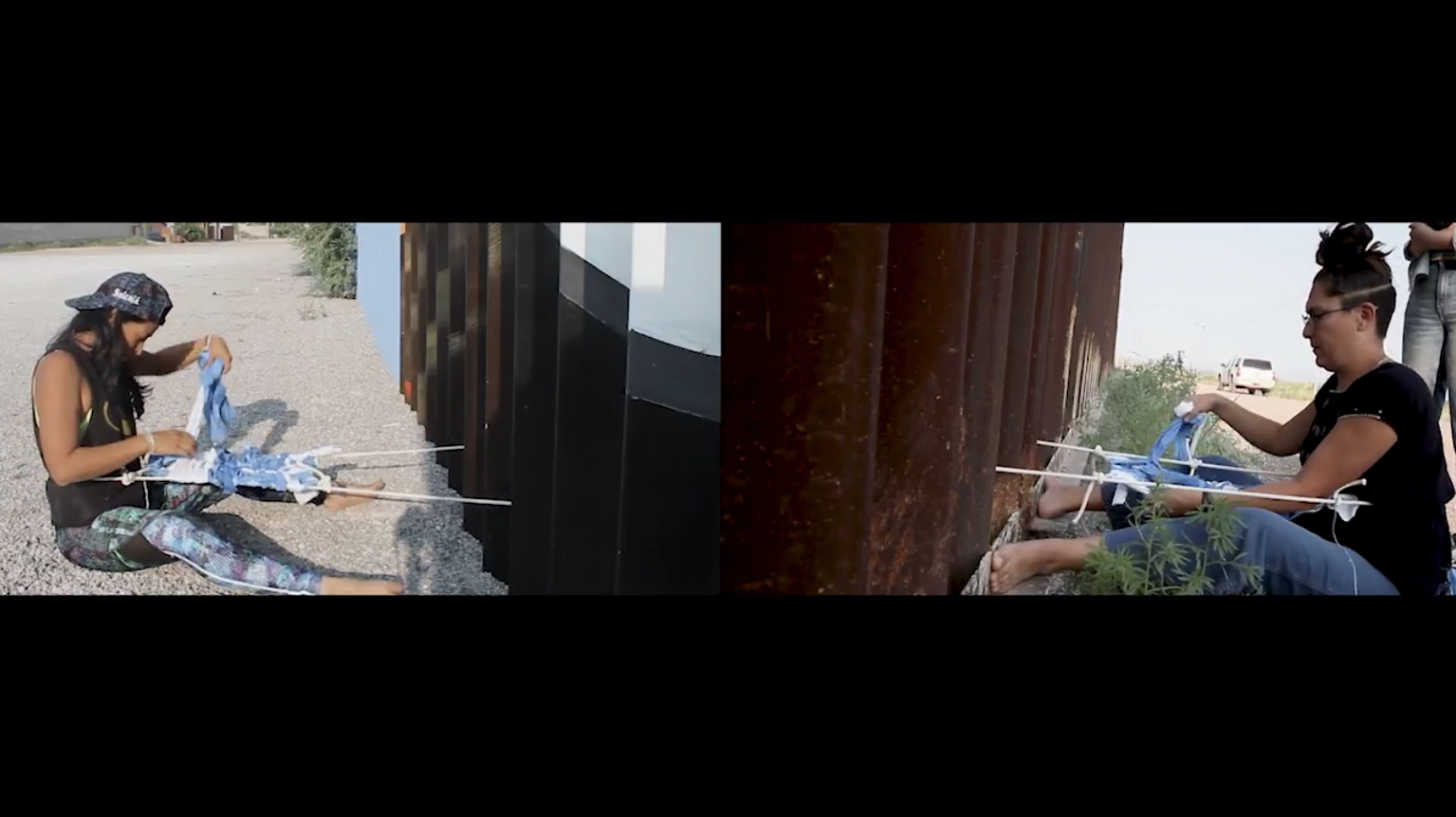

Left: "Tensíón" (2017). Performance documentation video. 2017 Edited by Cecilia Brawley. Video by M Jenea Sanchez and Natalie Gomez
Right: "Tensíón" (2017), Performance documentation of border wall intervention, performed with Jackie Amézquita. Image courtesy Tanya Aguiñiga and the AMBOS Project.
Tanya Aquiniga’s project AMBOS (Art Made Between Opposite Sides) seeks to foster greater interconnectedness between people on opposite sides of the US/Mexico border.
In her intervention Tensíón, Aquiniga is tied, through gaps in the border fence, to Guatemalan-American artist Jackie Amézquita. This work positions the horizontality of human intention and collaboration directly against the verticality of the border wall. Tensíón activates the space between the artists, and makes visible the gaps within a structure of exclusion. The two artists’ backs form the ends of a backstrap loom, on which they weave a simple textile working with the tension between their bodies and physical resistance to the border wall. The site of the work at the border between Douglas AZ and Sonora, Mexico is also the location of Amézquita’s attempted illegal entry to the US as a teenager to reunite with her mother.
In her intervention Tensíón, Aquiniga is tied, through gaps in the border fence, to Guatemalan-American artist Jackie Amézquita. This work positions the horizontality of human intention and collaboration directly against the verticality of the border wall. Tensíón activates the space between the artists, and makes visible the gaps within a structure of exclusion. The two artists’ backs form the ends of a backstrap loom, on which they weave a simple textile working with the tension between their bodies and physical resistance to the border wall. The site of the work at the border between Douglas AZ and Sonora, Mexico is also the location of Amézquita’s attempted illegal entry to the US as a teenager to reunite with her mother.
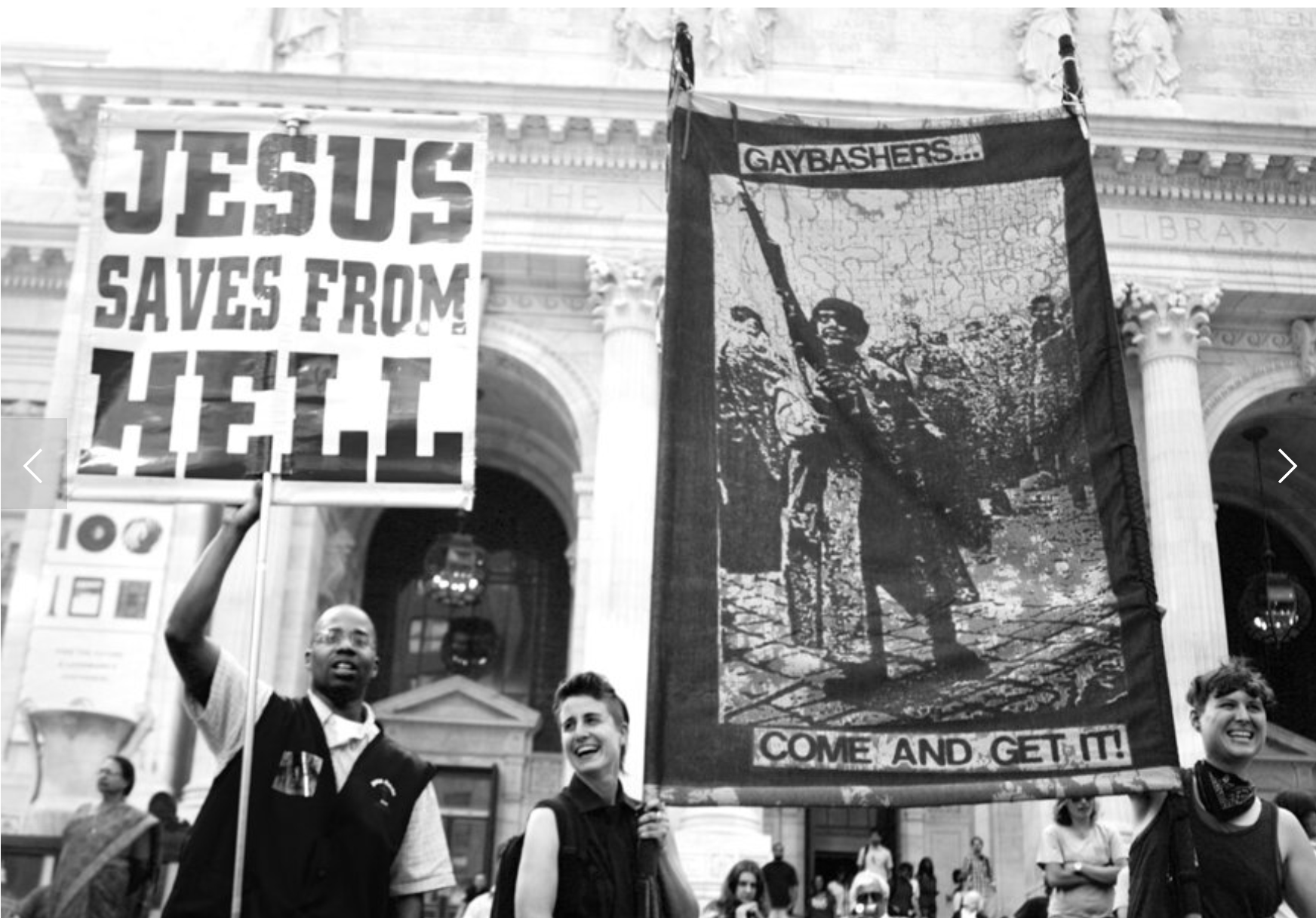
Gaybashers Come and Get It Jacquard-Woven Cotton and Lurex, hand-dyed fabric, crank-knit yarn, thread. 10' x 4'. 2011. Image: Matt Height/Queeruption
Protest can take many forms, such as in small interpersonal relations or in a broader public sphere.
LJ Roberts addresses a wide audience using a familiar form in their work Gaybashers Come and Get It. When activated in street protests, the work reads as a protest banner. But by referencing medeival heraldry or a knight’s battle banner, this work also addresses the violence of gay bashing from a position of strength. This vertical woven tapestry deployed publicly conjures an authoritative display of kingdom-hood. In addition to its jacquard woven verbal challenge “Gaybashers come and get it”, the work reframes the power dynamics involved in the exchange by ennobling and empowering its bearers.
Movements for social justice and social change flatten and question the levels of society to elevate universal ideals, and reveal the gaps in our understanding of others’ experience. In challenging social hierarchies and centering popular struggles, such movements and culture workers exploit possibilities for change inside the structure of society, and strive for a horizontal plane of relation.
Hannah Arendt wrote that one’s action (the work) is inextricably tied to and defined by the web of relationships that surround and define the actor in their world. Because of these relationships, one can never really produce a clear action or communication that perfectly reflects the perspective of the actor or speaker. Instead, every action, creation, and speech act exists by nature of being interpreted by a receiver, by the surrounding community or by culture. This interpretation produces a story, a version of the action or attempted communication that may or may not reflect the actor’s intention.3 These actions may be monumentalized, reviled in the media, or may live on in artworks, where they can be re-interpreted again and anew.
Textiles use a familiar, colloquial language that can enable connection between artist and viewer, participants, or individuals in a society. The work’s relationship to the horizontal plane of creation communicates the artist’s intention. Collective action and a focus on participation elevates the personal, the lived and the mundane, repositioning it to tell a story and stand as metaphor for the human condition. The invisible negative space inside of cloth, as inside of society, can be a site of experimentation, challenge and resistance. In looking at the radical potential of community building, collective action and inclusion in crafting new social realities, textiles provide both metaphor and meaning.
NOTES
1 Frtiz Haeg artist website, http://www.fritzhaeg.com/domestic-integrities/main.html
2 Lois Martin, The Direction of Cloth: The Horizontal Dimension. Surface Design Journal. Winter 2002. pg. 9
3 Hannah Arendt, The Human Condition: Action. 1958 pg. 184
BIBLIOGRAPHY
CAMIL
El NuMu
Divisor Pirata : An exhibition by Pia Camil https://en.elnumu.org/copy-of-margarita-azurdia-english-1
https://piacamil.me/Here-Comes-the-Sun
HAEG
The Possible
https://www.the-possible.org https://www.the-possible.org/texts/ThePossible_Index.pdf http://www.fritzhaeg.com/domestic-integrities/parts/a06-berkeley-bam.html
PAPE
Divisor. A Lygia Pape performance. 24 May, 2011 https://www.museoreinasofia.es/en/actividades/divisor-lygia-pape-performance
Being a Part of Living Art: Lygia Pape's Divisor (Divider) By Veronica Brown. The Met Museum April 3, 2017 https://www.metmuseum.org/blogs/met-live-arts/2017/divisor-lygia-pape
Channeling Lygia Pape’s Radical Relationship to Space By Elisa Wouk Almino, March 30, 2017 https://hyperallergic.com/368222/channeling-lygia-papes-radical-relationship-to-space/
Undo.net
Experiment Experiencia http://1995-2015.undo.net/it/mostra/5240
Lygia Pape
http://1995-2015.undo.net/it/mostra/121599
SUPPORTS/SURFACES
Painting as Theoretical Practice: Althusser and Supports/Surfaces. By Sami Siegelbaum Selva: A journal of the History of Art, 1 (Fall 2019) https://selvajournal.org/article/painting-as-theoretical-practice-althusser-and-supports-surfaces
Theory and Matter. By Raphael Rubenstein Art News. Sept 3, 2014. https://www.artnews.com/art-in-america/features/theory-and-matter-63030/
https://beartmagazine.com/exhibition-supportssurfaces-beginnings-le-carre-dart-nimes-france/
Unfurled: Supports/Surfaces to bring art inspired by the Paris riots to MOCAD By Lucas Maiman. Detroit Metro Times. Fri, Sep 28, 2018 https://www.metrotimes.com/the-scene/archives/2018/09/28/unfurled-supports-surfaces-to-bring-art-inspired-by-the-paris-riots-to-the-mocad
COVER PHOTO: documentation of Lygia Pape’s “Divisor” (“Divider”) (1968) in Rio de Janeiro projected at Met Museum